Global OLED-on-Silicon (OLEDoS) Market By Type, By Technology, By End Use Industry, By Region & Segmental Insights Trends and Forecast, 2024 – 2034
- Industry: Semiconductors & Electronics
- Report ID: TNR-110-1254
- Number of Pages: 420
- Table/Charts : Yes
- August, 2024
- Base Year : 2024
- No. of Companies : 10+
- No. of Countries : 29
- Views : 10075
- Covid Impact Covered: Yes
- War Impact Covered: Yes
- Formats : PDF, Excel, PPT
The global OLED-on-Silicon (OLEDoS) market is experiencing robust growth, driven by the rising demand for high-resolution microdisplays in applications like augmented reality (AR), virtual reality (VR), and automotive heads-up displays (HUDs). Key growth drivers include the increasing adoption of AR/VR technologies, advancements in consumer electronics, and the growing need for compact, energy-efficient displays.
Current trends indicate a shift towards integrating OLEDoS in military optics and medical imaging, where precision and clarity are paramount. Opportunities abound as ongoing R&D investments focus on enhancing display performance and scalability. As industries recognize the potential of OLEDoS technology, the market is poised for significant expansion, solidifying its position in next-generation display solutions. In terms of revenue, the global OLED-on-Silicon (OLEDoS) market was worth US$ 14.5 Bn in 2023, anticipated to witness a CAGR of 11.5% during 2024 – 2034.
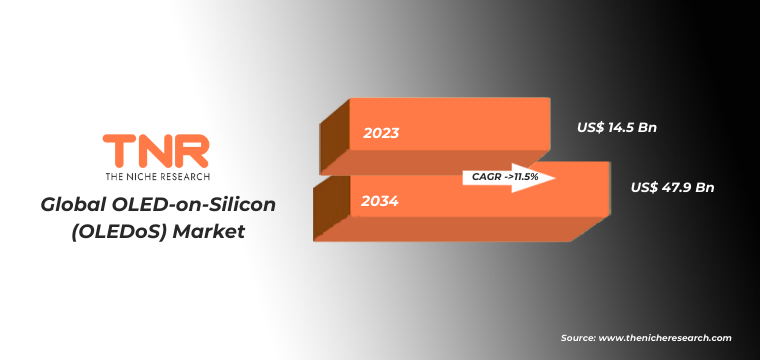
Global OLED-on-Silicon (OLEDoS) Market Dynamics
Global OLED-on-Silicon (OLEDoS) Market Growth Driver:
The global OLED-on-Silicon (OLEDoS) market is propelled by several key drivers. The surge in demand for high-resolution microdisplays in augmented reality (AR) and virtual reality (VR) applications is a major factor, as these technologies require compact and high-quality displays for immersive experiences. Additionally, advancements in consumer electronics, such as smartphones and wearable devices, are fueling the need for OLEDoS technology. The automotive industry’s growing integration of heads-up displays (HUDs) also drives demand, as OLEDoS offers the clarity and efficiency required for these applications. Enhanced research and development efforts aimed at improving display performance and reducing production costs further contribute to market growth.
Global OLED-on-Silicon (OLEDoS) Market Restraint:
Despite its potential, the OLED-on-Silicon (OLEDoS) market faces several challenges. High production costs associated with the complex manufacturing process limit scalability and affordability. Technical issues, such as brightness limitations and potential color degradation, can affect display quality and longevity. Additionally, intense competition from alternative technologies like MicroLED and Liquid Crystal on Silicon (LCOS) creates pressure on OLEDoS manufacturers to innovate continuously. Integration challenges, including size constraints and power consumption in compact devices, further complicate market adoption. Limited market awareness and understanding of OLEDoS benefits may also hinder growth, requiring increased educational and promotional efforts.
Global OLED-on-Silicon (OLEDoS) Market Opportunity:
The OLED-on-Silicon (OLEDoS) market presents several significant opportunities. The expanding use of AR and VR technologies offers substantial growth potential, as these applications demand high-resolution, compact displays. The automotive sector’s shift towards advanced heads-up displays (HUDs) provides additional opportunities for OLEDoS integration. Moreover, the defense and medical industries’ increasing need for precise, high-quality displays in night vision and imaging applications further drives demand. Ongoing research and development efforts aimed at overcoming technical challenges and improving production efficiency could lead to innovations that enhance market prospects. Strategic partnerships and collaborations with technology providers can also open new avenues for growth and market penetration.
Global OLED-on-Silicon (OLEDoS) Market Threats:
The global OLED-on-Silicon (OLEDoS) market faces several threats. Intense competition from alternative display technologies like MicroLED and LCOS poses a significant risk, as these alternatives offer comparable or superior performance in some applications. High production costs and complex manufacturing processes can limit market scalability and profitability. Technical challenges, such as achieving optimal brightness and durability, may affect the technology’s adoption. Additionally, potential disruptions in the supply chain for critical materials could impact production and delivery. Economic fluctuations and changes in industry regulations could also pose risks, influencing market dynamics and growth prospects.
Global OLED-on-Silicon (OLEDoS) Market Segmental Analysis:
Global OLED-on-Silicon (OLEDoS) Market By Type
Foldable segment has rapidly emerged as the fastest-growing segment in the global OLED-on-Silicon (OLEDoS) market, driven by its innovative application in consumer electronics. This growth is fueled by the increasing demand for flexible, high-resolution displays that enhance user experience in foldable smartphones, tablets, and wearables. OLEDoS technology, with its superior image quality and compact form factor, is ideally suited for these devices, offering both durability and high performance. As manufacturers continue to push the boundaries of device design, the ability of OLEDoS to provide seamless, high-resolution visuals in foldable formats becomes increasingly valuable. This trend is expected to accelerate as consumer preferences shift towards versatile, cutting-edge electronics.
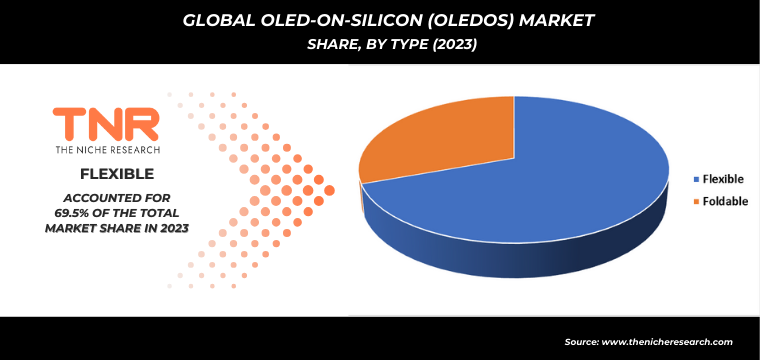
Global OLED-on-Silicon (OLEDoS) Market By Technology
In 2023, active matrix OLEDoS (AMOLEDoS) segment dominated the global OLED-on-Silicon (OLEDoS) market, capturing a substantial revenue share of 76.5%. This dominance is attributed to AMOLEDOS’s superior display quality, including enhanced resolution, brightness, and color accuracy, making it ideal for high-performance applications. Its active-matrix technology enables precise control over each pixel, which is crucial for advanced uses in augmented reality (AR) and virtual reality (VR) devices. As demand for high-resolution, dynamic displays continues to grow, AMOLEDOS is expected to maintain its leading position in the market.
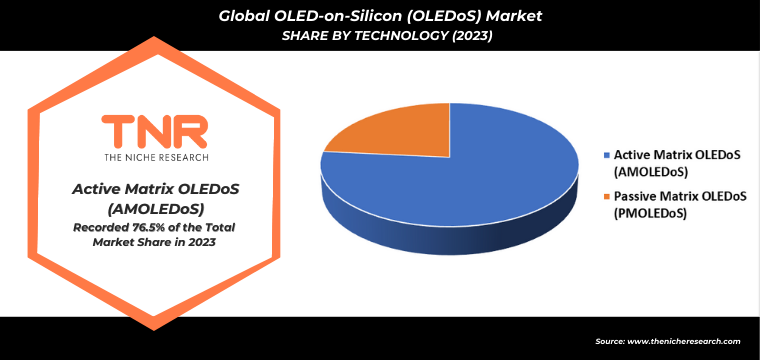
Global OLED-on-Silicon (OLEDoS) Market By End Use Industry
By end use industry, military & defense segment is anticipated to grow fastest over the forecast timeline in global OLED-on-Silicon (OLEDoS) market due to the increasing demand for high-resolution, durable displays in advanced optical systems and night vision technologies. OLEDoS technology provides superior image clarity and precision, which are crucial for applications like helmet-mounted displays, targeting systems, and surveillance equipment. The need for reliable and high-performance displays in tactical and strategic operations drives this growth, as military and defense sectors seek cutting-edge technology to enhance operational effectiveness and situational awareness.
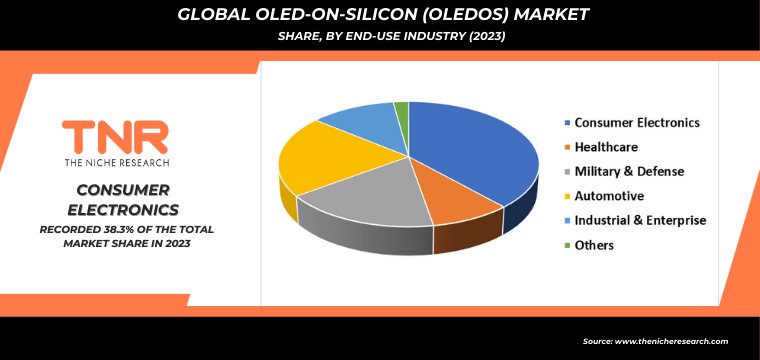
OLED-on-Silicon (OLEDoS) Market By Region
Europe is projected to be the fastest-growing region in the OLED-on-Silicon (OLEDoS) market during the forecast period. The region’s strong focus on technological innovation and research, coupled with substantial investments in advanced display technologies, fuels market expansion. Europe’s increasing adoption of OLED-on-Silicon in applications such as augmented reality (AR), virtual reality (VR), and automotive heads-up displays (HUDs) further propels growth. Additionally, the presence of leading technology companies and research institutions in Europe enhances development and commercialization efforts. As demand for high-resolution, compact displays continues to rise, Europe’s market is set to experience significant growth.
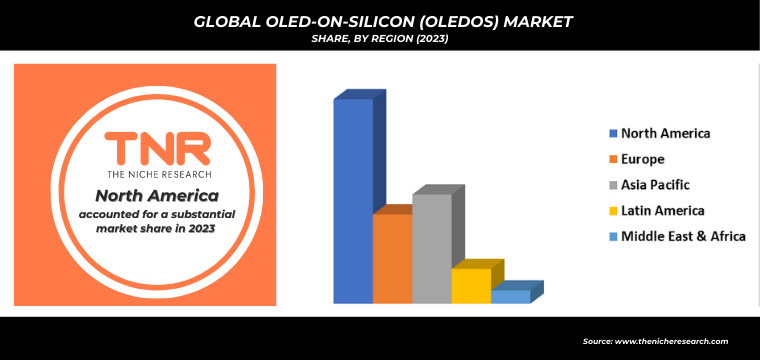
Competitive Landscape
The competitive landscape of the global OLED-on-Silicon (OLEDoS) market is marked by key players like Sony, eMagin, and MicroOLED. These companies drive innovation through substantial R&D investments. Intense competition from technologies like MicroLED and LCOS requires ongoing advancements to maintain market leadership and differentiate offerings.
Some of the players operating in the OLED-on-Silicon (OLEDoS) market are
- AU Optronics
- BOE Technology
- eMagin
- EPSON
- Innolux Corp.
- INT Tech
- Japan Display Inc.
- Kopin Corporation
- LG Display Corporation
- MICROOLED Technologies
- Microtips Technology
- SAMSUNG
- Sony
- Yunnan OLiGHTEK Opto-Electronic Technology Co., Ltd.
- Other Industry Participants
Global OLED-on-Silicon (OLEDoS) Market Scope:
| Report Specifications | Details |
| Market Revenue in 2023 | US$ 14.5 Bn |
| Market Size Forecast by 2034 | US$ 47.9 Bn |
| Growth Rate (CAGR) | 11.5% |
| Historic Data | 2016 – 2022 |
| Base Year for Estimation | 2023 |
| Forecast Period | 2024 – 2034 |
| Report Inclusions | Market Size & Estimates, Market Dynamics, Competitive Scenario, Trends, Growth Factors, Market Determinants, Key Investment Segmentation, Product/Service/Solutions Benchmarking |
| Segments Covered | By Type, By Technology, By End Use Industry, By Region |
| Regions Covered | North America, Europe, Asia Pacific, Middle East & Africa, Latin America |
| Countries Covered | U.S., Canada, Mexico, Rest of North America, France, The UK, Spain, Germany, Italy, Nordic Countries (Denmark, Finland, Iceland, Sweden, Norway), Benelux Union (Belgium, The Netherlands, Luxembourg), Rest of Europe, China, Japan, India, New Zealand, Australia, South Korea, Southeast Asia (Indonesia, Thailand, Malaysia, Singapore, Rest of Southeast Asia), Rest of Asia Pacific, Saudi Arabia, UAE, Egypt, Kuwait, South Africa, Rest of Middle East & Africa, Brazil, Argentina, Rest of Latin America |
| Key Players | AU Optronics, BOE Technology, eMagin, EPSON, Innolux Corp., INT Tech, Japan Display Inc., Kopin Corporation, LG Display Corporation, MICROOLED Technologies, Microtips Technology, SAMSUNG, Sony, Yunnan OLiGHTEK Opto-Electronic Technology Co.,Ltd. |
| Customization Scope | Customization allows for the inclusion/modification of content pertaining to geographical regions, countries, and specific market segments. |
| Pricing & Procurement Options | Explore purchase options tailored to your specific research requirements |
| Contact Details | Consult With Our Expert
Japan (Toll-Free): +81 663-386-8111 South Korea (Toll-Free): +82-808- 703-126 Saudi Arabia (Toll-Free): +966 800-850-1643 United Kingdom: +44 753-710-5080 United States: +1 302-232-5106 E-mail: askanexpert@thenicheresearch.com
|
Key Developments:
- In October 2021, MICROOLED Technologies announced the launch of ActiveLook Eyewear, a discreet augmented reality device designed to project navigational information onto a heads-up display.
- In July 2020, INT Tech unveiled a 0.7″ 2300 PPI native RGB AMOLED micro-display solution tailored for Extended Reality (XR) devices.
Global OLED-on-Silicon (OLEDoS) Market Segmentation:
By Type
- Flexible
- Foldable
By Technology
- Active Matrix OLEDoS (AMOLEDoS)
- Passive Matrix OLEDoS (PMOLEDoS)
By End-Use Industry
- Consumer Electronics
- Healthcare
- Military & Defense
- Automotive
- Industrial & Enterprise
- Others
By Region
- North America (U.S., Canada, Mexico, Rest of North America)
- Europe (France, The UK, Spain, Germany, Italy, Nordic Countries (Denmark, Finland, Iceland, Sweden, Norway), Benelux Union (Belgium, The Netherlands, Luxembourg), Rest of Europe)
- Asia Pacific (China, Japan, India, New Zealand, Australia, South Korea, Southeast Asia (Indonesia, Thailand, Malaysia, Singapore, Rest of Southeast Asia), Rest of Asia Pacific)
- Middle East & Africa (Saudi Arabia, UAE, Egypt, Kuwait, South Africa, Rest of Middle East & Africa)
- Latin America (Brazil, Argentina, Rest of Latin America)
Report Layout:
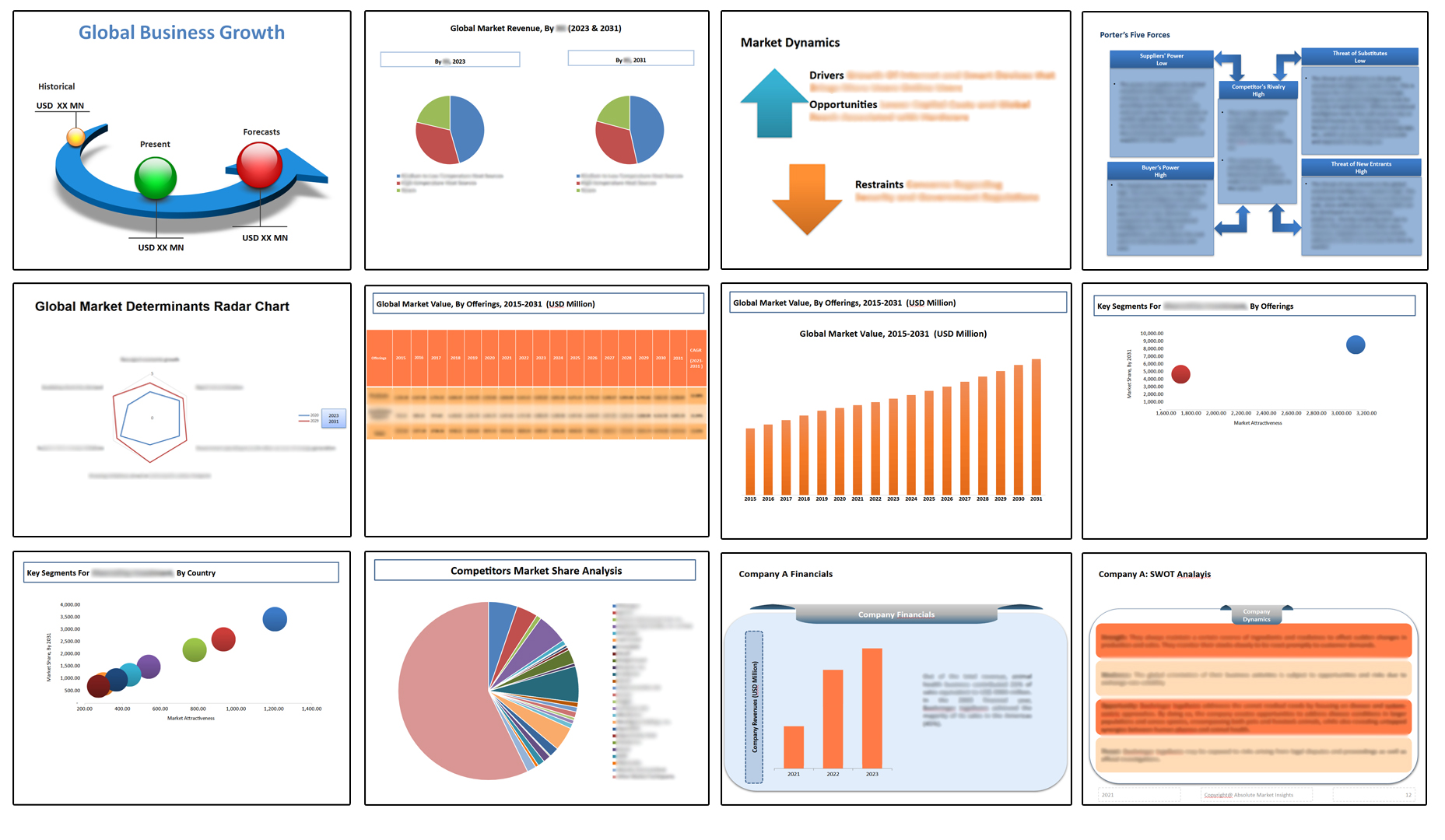
Table of Contents
Note: This ToC is tentative and can be changed according to the research study conducted during the course of report completion.
**Exclusive for Multi-User and Enterprise User.
Global OLED-on-Silicon (OLEDoS) Market Segmentation:
By Type
- Flexible
- Foldable
By Technology
- Active Matrix OLEDoS (AMOLEDoS)
- Passive Matrix OLEDoS (PMOLEDoS)
By End-Use Industry
- Consumer Electronics
- Healthcare
- Military & Defense
- Automotive
- Industrial & Enterprise
- Others
By Region
- North America (U.S., Canada, Mexico, Rest of North America)
- Europe (France, The UK, Spain, Germany, Italy, Nordic Countries (Denmark, Finland, Iceland, Sweden, Norway), Benelux Union (Belgium, The Netherlands, Luxembourg), Rest of Europe)
- Asia Pacific (China, Japan, India, New Zealand, Australia, South Korea, Southeast Asia (Indonesia, Thailand, Malaysia, Singapore, Rest of Southeast Asia), Rest of Asia Pacific)
- Middle East & Africa (Saudi Arabia, UAE, Egypt, Kuwait, South Africa, Rest of Middle East & Africa)
- Latin America (Brazil, Argentina, Rest of Latin America)
The Niche Research approach encompasses both primary and secondary research methods to provide comprehensive insights. While primary research is the cornerstone of our studies, we also incorporate secondary research sources such as company annual reports, premium industry databases, press releases, industry journals, and white papers.
Within our primary research, we actively engage with various industry stakeholders, conducting paid interviews and surveys. Our meticulous analysis extends to every market participant in major countries, allowing us to thoroughly examine their portfolios, calculate market shares, and segment revenues.
Our data collection primarily focuses on individual countries within our research scope, enabling us to estimate regional market sizes. Typically, we employ a bottom-up approach, meticulously tracking trends in different countries. We analyze growth drivers, constraints, technological innovations, and opportunities for each country, ultimately arriving at regional figures.Our process begins by examining the growth prospects of each country. Building upon these insights, we project growth and trends for the entire region. Finally, we utilize our proprietary model to refine estimations and forecasts.
Our data validation standards are integral to ensuring the reliability and accuracy of our research findings. Here’s a breakdown of our data validation processes and the stakeholders we engage with during our primary research:
- Supply Side Analysis: We initiate a supply side analysis by directly contacting market participants, through telephonic interviews and questionnaires containing both open-ended and close-ended questions. We gather information on their portfolios, segment revenues, developments, and growth strategies.
- Demand Side Analysis: To gain insights into adoption trends and consumer preferences, we reach out to target customers and users (non-vendors). This information forms a vital part of the qualitative analysis section of our reports, covering market dynamics, adoption trends, consumer behavior, spending patterns, and other related aspects.
- Consultant Insights: We tap into the expertise of our partner consultants from around the world to obtain their unique viewpoints and perspectives. Their insights contribute to a well-rounded understanding of the markets under investigation.
- In-House Validation: To ensure data accuracy and reliability, we conduct cross-validation of data points and information through our in-house team of consultants and utilize advanced data modeling tools for thorough verification.
The forecasts we provide are based on a comprehensive assessment of various factors, including:
- Market Trends and Past Performance (Last Five Years): We accurately analyze market trends and performance data from preceding five years to identify historical patterns and understand the market’s evolution.
- Historical Performance and Growth of Market Participants: We assess the historical performance and growth trajectories of key market participants. This analysis provides insights into the competitive landscape and individual company strategies.
- Market Determinants Impact Analysis (Next Eight Years): We conduct a rigorous analysis of the factors that are projected to influence the market over the next eight years. This includes assessing both internal and external determinants that can shape market dynamics.
- Drivers and Challenges for the Forecast Period:Identify the factors expected to drive market growth during the forecast period, as well as the challenges that the industry may face. This analysis aids in deriving an accurate growth rate projection.
- New Acquisitions, Collaborations, or Partnerships: We keep a close watch on any new acquisitions, collaborations, or partnerships within the industry. These developments can have a significant impact on market dynamics and competitiveness.
- Macro and Micro Factors Analysis:A thorough examination of both macro-level factors (e.g., economic trends, regulatory changes) and micro-level factors (e.g., technological advancements, consumer preferences) that may influence the market during the forecast period.
- End-User Sentiment Analysis: To understand the market from the end-user perspective, we conduct sentiment analysis. This involves assessing the sentiment, preferences, and feedback of the end-users, which can provide valuable insights into market trends.
- Perspective of Primary Participants: Insights gathered directly from primary research participants play a crucial role in shaping our forecasts. Their perspectives and experiences provide valuable qualitative data.
- Year-on-Year Growth Trend: We utilize a year-on-year growth trend based on historical market growth and expected future trends. This helps in formulating our growth projections, aligning them with the market’s historical performance.
Research process adopted by TNR involves multiple stages, including data collection, validation, quality checks, and presentation. It’s crucial that the data and information we provide add value to your existing market understanding and expertise. We have also established partnerships with business consulting, research, and survey organizations across regions and globally to collaborate on regional analysis and data validation, ensuring the highest level of accuracy and reliability in our reports.








